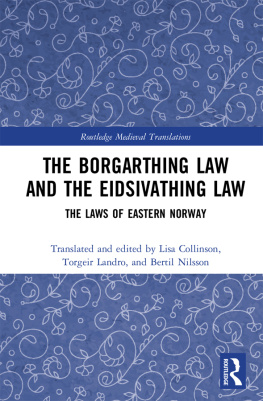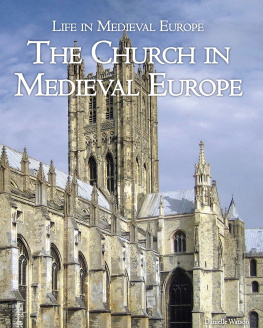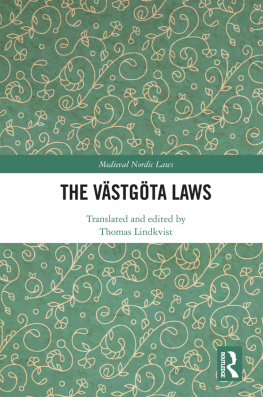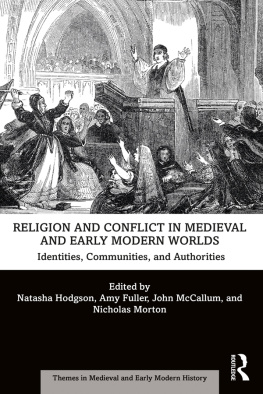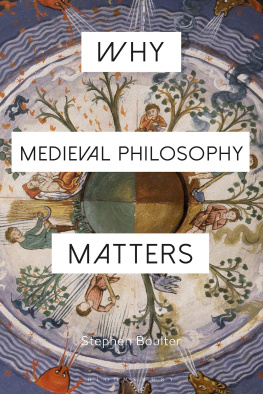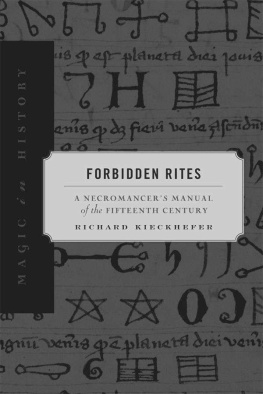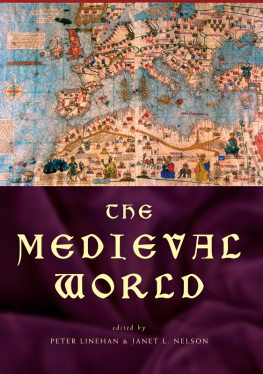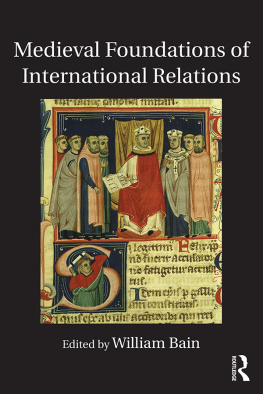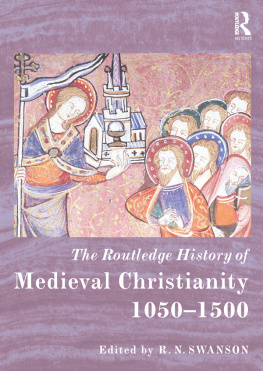The Borgarthing Law and the Eidsivathing Law
The Borgarthing Law and the Eidsivathing Law is dedicated to two closely linked medieval laws which were intended to cover adjacent legal provinces in eastern Norway, around and beyond the modern capital, Oslo.
The core of this book consists of new translations of the two laws, based on the recent editions and translations into modern Norwegian by Eyvind Fjeld Halvorsen and Magnus Rindal. Individual rules cover subjects such as Church rites, prohibitions, property, and payments, and shed light on medieval ideas relating to matters as diverse as disability, sexual relations, witchcraft, and forbidden foods. The volume contains a general introduction by Torgeir Landro and Bertil Nilsson, in addition to a translators introduction by Lisa Collinson, summarizing in English some of the information on manuscripts and relevant linguistic studies outlined by Halvorsen and Rindal. The translated texts in English are also supplemented by footnotes, supplying key readings from the original, in some cases with significant variants from relevant manuscripts.
With a commentary on the individual chapters after each translation, drawing on recent scholarship on medieval law, Church history, and other relevant historical fields, this book is an ideal resource for students and scholars of medieval Norwegian legal history.
Lisa Collinson is Research Lead for Museums and Special Collections, University of Aberdeen. Her previous work has examined the legal and literary history of medieval Scandinavia and the British Isles.
Torgeir Landro is Associate Professor at NLA University College, Norway. His previous publications deal with the reception of canon law in medieval Norway.
Bertil Nilsson is Professor Emeritus of History of Christianity at the University of Gothenburg, Sweden. His previous publications deal with medieval canon law as well as the way in which the encounter between religions developed during the process of Christianization in the Scandinavian kingdoms.
Medieval Nordic Laws
Series editors: Stefan Brink and Ditlev Tamm
Medieval Nordic Laws, edited by Stefan Brink and Ditlev Tamm, is part of the Routledge Medieval Translations series. These translations are the first translations into English of the earliest laws of Scandinavia, and are some of the earliest written sources for Scandinavia. These translated laws emanate from an international project of the same name and have never before been introduced to an international audience.
Guta Lag and Guta Saga
The Law and History of the Gotlanders
Christine Peel
The Danish Medieval Laws
The Laws of Scania, Zealand and Jutland
Ditlev Tamm and Helle Vogt
The Liber legis Scaniae
The Latin Text with Introduction, Translation and Commentaries
Ditlev Tamm
The Borgarthing Law and the Eidsivathing Law
The Laws of Eastern Norway
Lisa Collinson, Torgeir Landro, and Bertil Nilsson
The Borgarthing Law and the Eidsivathing Law
The Laws of Eastern Norway
Translated and edited by Lisa Collinson, Torgeir Landro, and Bertil Nilsson
First published 2021
by Routledge
2 Park Square, Milton Park, Abingdon, Oxon OX14 4RN
and by Routledge
52 Vanderbilt Avenue, New York, NY 10017
Routledge is an imprint of the Taylor & Francis Group, an informa business
Lisa Collinson, Torgeir Landro, and Bertil Nilsson
The right of Lisa Collinson, Torgeir Landro, and Bertil Nilsson to be identified as the authors of the editorial material, and of the authors for their individual chapters, has been asserted in accordance with sections 77 and 78 of the Copyright, Designs and Patents Act 1988.
All rights reserved. No part of this book may be reprinted or reproduced or utilised in any form or by any electronic, mechanical, or other means, now known or hereafter invented, including photocopying and recording, or in any information storage or retrieval system, without permission in writing from the publishers.
Trademark notice: Product or corporate names may be trademarks or registered trademarks, and are used only for identification and explanation without intent to infringe.
British Library Cataloguing-in-Publication Data
A catalogue record for this book is available from the British Library
Library of Congress Cataloging-in-Publication Data
Names: Collinson, Lisa, translator, editor. | Landro, Torgeir, translator, editor. | Nilsson, Bertil, 1951translator, editor.
Title: The Borgarthing law and the Eidsivathing law : the laws of Eastern Norway / translated and edited by Lisa Collinson,Torgeir Landro, and Bertil Nilsson.
Description: Milton Park, Abingdon, Oxon ; New York, NY : Routledge, 2021. | Includes bibliographical references and index.
Identifiers: LCCN 2020031516 | ISBN 9780367646424 (hardback) | ISBN 9781003125617 (ebook)
Subjects: LCSH: Law, MedievalNorwaySources. | LawNorwayHistorySources.
Classification: LCC KKN125 .B67 2021 | DDC 349.48109/021dc23
LC record available at https://lccn.loc.gov/2020031516
ISBN: 978-0-367-64642-4 (hbk)
ISBN: 978-1-003-12561-7 (ebk)
Typeset in Times New Roman
by Apex CoVantage, LLC
The oldest laws of the Nordic countries were written in the vernacular. The earliest manuscripts stem from the thirteenth century and are younger than the texts of the laws, some of which date back to the twelfth century. They are, of course, important for the fields of Nordic law and legal history, but are equally significant for other fields, being amongst the oldest written sources for medieval Nordic social history (including household, administrative, ecclesiastical, and agrarian matters), as well as for philology, as some of the oldest written documents we have in the vernacular.
For a long time, these laws were intensely studied by legal historians as the foundation of national law. During the last decade, there has been a revival of interest in these early laws in the Nordic countries, manifested in, for example, an influential conference series on early law at the Carlsberg Academy in Denmark, and the initiative of an interdisciplinary network project, called Medieval Nordic Laws (MNL), funded by The Leverhulme Trust and based at the University of Aberdeen, along with some other local initiatives. In order to open up the floodgates to international interest and research on these laws and to facilitate comparison, the decision was made in the MNL project to translate the laws into English. Besides the obvious scoop of international interest in the laws based on new translations, another gain with this initiative was the rethinking of the position of the laws in connection with the redaction of new introductions to the laws. The Nordic medieval laws were earlier subjected to thorough analysis from both legal and historical points of view and have been translated into modern Nordic languages. This happened mainly in the 1930s and 40s, but the laws have long played a central role in Nordic legal history. In the second part of the nineteenth century, the Nordic laws were seen in German scholarship as important expressions of the so-called Germanenrechte, and intense learning was used in developing and describing a specific Nordic variant of such law. This approach was never fully accepted in the Nordic countries, and a more critical study of the laws based on the idea that they reflected both older and newer layers of law started in the 1920s and continued to the 1980s in Scandinavia. Todays legal historians in the Nordic countries tend to see the laws in a European context and generally as new law written down as such. Most Nordic scholarship, however, has only been published in Nordic languages. Research into the medieval legal world has continued in later years; these translations and introductions in English thus make the newest research accessible to an international public. Iceland holds a somewhat different position and has already seen two of the old law codes,

